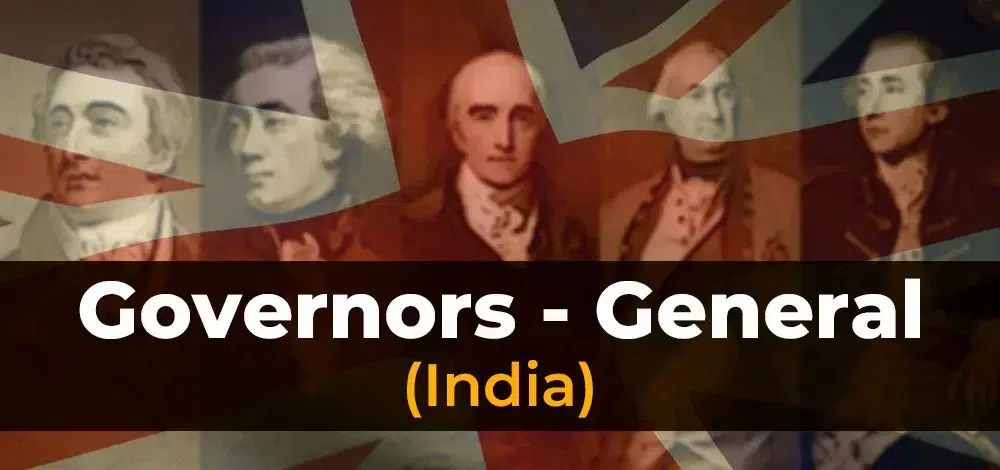| Viceroy |
Significant Events |
| Lord Canning (1856- 1862) |
- The Government of India Act of 1858 removed the East India Company’s rule and transferred authority to the Crown.
- During his tenure, three universities were founded in Calcutta, Madras, and Bombay; the Revolt of 1857; and the 1861 Indian Councils Act.
|
| Lord Elgin (1862-1863) |
- He was in power when the Wahabi Movement began.
|
| Lord John Lawrence (1864-1869) |
- During his service, the Bhutan War (1865) took place, and 1865 saw the establishment of the High Courts at Calcutta, Bombay, and Madras.
|
| Lord Mayo (1869-1872) |
- The financial distribution between the federal government and the state was established.
- In 1872, India conducted its first census.
- The establishment of the Mayo College for the royal elite; and the creation of the India Statistical Survey.
- Lord Mayo was the only Governor-General to pass away in India. He was assassinated in Port Blair by Sher Ali Afridi.
|
| Lord Northbrook (1872-1876) |
- In 1872, the Universal Marriage Act introduced civil marriage. Inter-caste marriage was permitted by this law, and Arya Samaj was founded.
- In Punjab, the Kuka Movement was seen.
|
| Lord Lytton (1876 -1880) |
- The Vernacular Press Act (1878) and the Arms Act (1878) were among the laws that were passed; the Second Afghan War lasted from 1878 to 1880;
- Kaiser-i-Hind became the title of Queen Victoria. which means “Queen Empress of India”
|
| Lord Ripon (1880 -1884) |
- The Vernacular Press Act (1882) was abolished in response to criticism. 1881 saw the introduction of the first Factory Act.
- The Ilbert Bill dispute (1883–1844), the Hunter Commission on Education (1882), and a government resolution on the formation of local self-governance were all passed in 1882.
|
| Lord Dufferin (1884 -1888) |
- The Third Burmese War (1885–1866). The founding of the Indian National Congress in 1885 was among the most notable occasions.
|
| Lord Lansdowne (1888 -1894) |
- Indian Councils Act, 1892. Another Factory Act was introduced in 1891.
- In 1893, the Durand Commission was established.
|
| Lord Elgin II (1894 -1899) |
- The first British officer, Rands, was killed by the Chapekar brothers, Ramkrishna and Damodar. It was India’s first political assassination under British rule.
|
| Lord Curzon (1899 -1905) |
- The Universities Commission was established in 1902, while the Police Commission was established the same year.
- The 1904 Indian Universities Act was introduced.
- Curzon’s masterful contribution to the British Policy of Divide and Rule was the partition of Bengal in 1905.
|
| Lord Minto II (1905 -1910) |
- Congress split in Surat (1907), The Muslim League was founded in 1906, and Morley-Minto Reforms were implemented in 1909.
|
| Lord Hardinge II (1910-1916) |
- The Hindu Mahasabha was established in 1915, the Partition of Bengal was revoked in 1911, and the British capital moved from Calcutta to Delhi in the same year.
|
| Lord Chelmsford (1916 -1921) |
- India in Chelmsford experienced much upheaval and tragedy.
- In 1916, the Lucknow Pact was concluded.
- In 1917, the Champaran Satyagraha began.
- The August Declaration of Montagu (1917).
- The Introduction of the Government of India Act (1919).
- The Black Laws or the Rowlatt Act (1919) were put into effect. protests were held across the country.
- The Jallianwalla Bagh Massacre (1919), one of the most horrific incidents in Indian history, resulted from this.
- Beginning of the Khilafat and non-cooperation movements
|
| Lord Reading (1921 -1926) |
- The Chauri Chaura event, which forced Mahatma Gandhi to end the Non-Cooperation Movement in 1922, the founding of the Swaraj Party, the Kakori Conspiracy the train robbery of 1925 all took place.
|
| Lord Irwin (1926 -1931) |
- In 1927, the Simon Commission visited India.
- Indian States Commission, Harcourt Butler (1927).
- 1928 Nehru Report
- 1929 Deepavali Declaration
- The Purna Swaraj Resolution was adopted during the 1929 Congress session in Lahore.
- The Civil Disobedience Movement was effectively launched that same year as a result of the revolutionary Dandi March, which took place from March 12 to April 6, 1930.
- 1930 saw the first Round Table Conference.
- 1931 Gandhi-Irwin Pact
|
| Lord Willingdon (1931-1936) |
- Second and Third Round Table Conferences (1932). creation of the Communal Award (1932).
- The disagreements between Mahatma Gandhi and Dr BR Ambedkar about separate Dalit electorates were settled by the Poona Pact in 1932.
- 1935 Government of India Act Passed.
|
| Lord Linlithgow (1936-1944) |
- Resignation of ministers of Congress (1939), following the start of the Second World War.
- 1939 Tripuri Crisis and the founding of the Front bloc.
- Muslim League Resolution of Lahor, 1940, calling for a Muslim-only state.
- 1940’s August Offer.
- The Indian National Army was founded in 1941.
- 1942’s Cripps Mission.
- 1942 Quit India Movement.
|
| Lord Wavell (1944 -1947) |
- The Wavell Plan and the Simla Conference (1942). C. Rajagopalachari’s CR Formula (1944).
- 1946 Cabinet Mission
- The Muslim League declared January 31 as Direct Action Day (1946).
- Clement Attlee’s announcement of the end of British sovereignty in India (1947)
|
| Lord Mountbatten (1947 -1948) |
- Redcliff Commission (1947), the June Third Plan or Mountbatten Plan (1947), and India’s Independence (15 August 1947)
|




